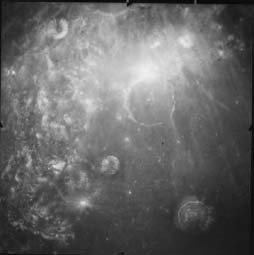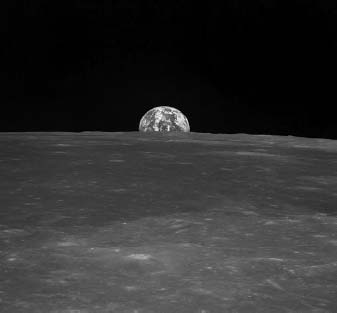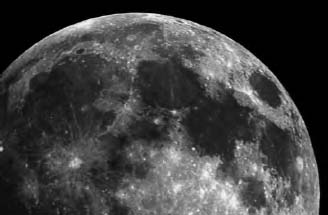Ancient Aliens on the Moon (20 page)
Read Ancient Aliens on the Moon Online
Authors: Mike Bara

Corrected footprint map for AS10-30-4421.
In reviewing the NASA footprint map and comparing it to the AS10-30-4414 to 4421 series, I realized that the footprint map couldn’t be right. If it was, and the spacecraft was travelling due west along the south side of Crisium, then the crater Picard
had
to get smaller and smaller in each of the successive photos, because it would be getting farther and farther away. But it didn’t. Picard, if anything, got
bigger
in each successive photo.

Lunar domes, imagined and real.
What this meant was that the original image map was in error (or deliberately altered) and Apollo 10 had actually been traversing the edge of Mare Crisium on a northwest trajectory. It also meant that two features which were supposedly outside the photographic parameters of 4421 were actually in full view of it—and they fit all the requirements to be the source of the bright flare and the watch crystal like domes which caused it. So this solved the mystery of why we couldn’t find what might have caused the reflections off of the mountains. The reflections were off of two domes on floor of Mare Crisium itself, covering the craters Cleomedes F and Cleomedes Fa.
So here we had the first photographic evidence of at least one (and possibly two) intact, watch crystal type glass domes over a pair of craters in the Mare Crisium region. I have to emphasize how lucky we are to even have this confirming image of the glass domes over the Cleomedes craters. If it weren’t for the quick reaction the astronaut holding the camera to turn back and shoot the picture under ideal (and rare) circumstances, we might never have had a clear, edge on shot of the domes. And we might never have had a clue about what is waiting for us on the floor of Mare Crisium if we ever successfully land there.
These types of domes would have represented the last line of defense against meteor bombardment for an ancient alien settlement there. With the eroded, structural lattice type structures overhead, providing the upper layers of protection, the lower domes would have enabled a pressurized, livable environment on the lunar surface. What might still be preserved underneath those structures is a matter of conjecture because we don’t know if they are still sealed and pressurized, or if they are long since abandoned. Sadly, there are precious few photos of the inside of Cleomedes F and Cleomedes Fa, and they are of rather poor quality, so a full analysis of the contents of these lunar “arcologies” (architectural ecologies) will have to wait for further data from later missions. But I have to wonder if we get the data if we’ll even be allowed to see it.

“Malibu” from NASA frame AS11-42-6223.
As part of our study of the mountains around the north shore of Mare Crisium, Steve came across a number of oddly geometric formations along the mountain tops. One was especially intriguing and very close to the locations of the two glass domes. Spotted on NASA frame AS11-42-6223, one hilltop showed what appeared to be a structure built right into the mountainside.
Nicknamed “Malibu” by Steve because of its location on a hillside, this building conformed to the contour of the hillside, had straight square walls at 90-degree angles to each other, and also had internal walls (again at 90 degrees) dividing the structure into numerous subsections or rooms. There was also a central spine visible and what might have even been doorways and entrances in several spots.
Now, on the negatives ordered by Steve in the mid 1990s, Malibu stands out like a sore thumb on the image. But today, if you download AS11-42-6223 from the online NASA archives, all you will see is a faint blur on the hillside where the structure appears. Again, it appears that Brookings is still alive and well, and NASA is still whitewashing images to hide the “real” Moon.
No manned landings were ever attempted on Mare Crisium, although one unmanned mission, the Soviet
Luna 24
, did land there successfully far from any of the structures we’ve talked about in this chapter and return a soil sample to Earth. Still, there have been enough solved and unsolved mysteries uncovered in the area to conclude that it is a major source of Ancient Alien ruins, if not active archeological sites. But there is one issue with Crisium that is still outstanding; why is it so dark?

Al Worden’s “gauzy haze” over Mare Crisium.
As I said earlier, the traditional model of the formation of the maria, the dark areas on the front face of the Moon, is that they contain dark basaltic lavas. But samples returned from Crisium and other mare show very little of the volcanic rock that could account for this. As we have seen from Apollo 15 Command Module pilot Al Worden’s own comments, there seems to be a gauzy haze over large parts of Mare Crisium, and this haze can be confirmed in numerous photos of the area.
The working theory is that this gauzy haze is caused by looking down through an intervening medium, a transparent (or semi-transparent) lattice-work of glass structures that were erected in the long distant past as a meteor shield to protect the surface installations much like our own atmosphere protects us here on Earth. When the sunlight hits this just right, you get a bright flare, like in the image above. But in general, when looking at the Moon from a distance, the maria like Crisium tend to be very dark. There’s a reason for this, and it all but confirms the existence of massive glass domes.

Earthrise.
When we look at the Earth from space, we see white clouds, light colored land masses and very deep blue oceans. The reason for this is that the clouds are the highest in the atmosphere, meaning that they are reflecting more light back to the camera, and at a faster rate. Since they are returning more light, the clouds are the lightest. The surface areas meanwhile are darker, because they are a bit farther away from the camera than the clouds and therefore the light has to travel farther before it is reflected back. The deep blue oceans are therefore the darkest, because the light has to travel all the way to the ocean floor before it is reflected back to the camera’s “eye.”
The same idea, but slightly inverted, applies to the Moon.
The lighter areas are the areas where these glass structures most likely do not exist or are at least less densely packed. Therefore they reflect the light back more directly. The much darker maria are the areas where the glass scaffolding acts like an atmosphere, scattering the light into the blue range of spectrum and making it pass through multiple layers (and multiple prism’s) before it finally reaches the surface and is reflected back in the multi-colored spectrum we see in today’s color enhanced images of the Moon.

The Moon. Darker areas may represent locations of highest density of glass ruins.
What this all adds up to is that the Moon is a very different place than the long-dead, rock strewn desolate landscape we’ve been led to believe by NASA and the Brookings crowd. What you are about to find out is just how different.
But first…
1
W.R.Corliss’s Mysterious Universe
, page 237 (Jackson, J.G.; English Mechanic, 35:326, 1882)
2
W.R.Corliss’s Mysterious Universe
, page 236 (Hardy, Jas. D.; British Astronomical Association, Journal, 7:139-141, 1897)
3
W.R.Corliss’s Mysterious Universe
, page 227 (Anonymous, Strolling Astronomer, 10:20, 1956)
4
http://the-moon.wikispaces.com/O’Neill’s+Bridge
5
BBC radio interview (Patrick Moore’s Armchair Astronomy, Patrick Moore, 1984, Patrick Stephens Ltd., U.K
6
Transcript by Isabel L. Davis, of Civilian Saucer Intelligence, N.Y.C. “The Flying Saucer Conspiracy,” Maj.(ret) Donald E. Keyhoe, Henry Holt & Co., First Edition 1955
7
http://www.vgl.org/webfiles/lan/picard.htm
WHO MOURNS FOR APOLLO?
I
n the last decade, I have become increasingly alarmed as a particularly silly and damaging urban myth has begun to take hold. Promoted by a few well known authors such as David Percy, Bill Kaysing, Ralph Rene’ and the late James Collier, this latest twist on the current conspiracy nation fad is based on a simple, if unbelievably naive and absurd notion—that the Apollo missions and subsequent Moon landings were faked. Even after Percy’s late 1990’s
Fortean Times
article was pretty much taken apart by readers, references to the “fake” landings began to creep into popular culture, springing up in such diverse places as Jay Leno’s Tonight Show monologue and commercials featuring ESPN’s Chris Berman. I think it is very important, especially for young readers who may not have studied this in great depth, to understand the difference between a good conspiracy theory and a bad one. And the idea that the Moon landings were faked is definitely a bad one.
Admittedly, I thought this whole issue was put quite nicely to rest in August 1997, when my co-author on
Dark Mission
, Richard C. Hoagland, debated James Collier on Art Bell’s
Coast to Coast AM
radio program. The results of that debate can only be described as an unmitigated humiliation for Collier, who turned out to be totally out of his element and misinformed on the general subjects of space travel, physics, engineering, NASA, and Apollo itself. But I have to keep in mind that every ten years or so, a new generation comes along and they have to be reminded of the truth and the facts.